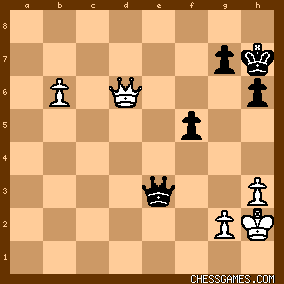| Chessical: Tarrasch and Schlechter reprised this game Tarrasch vs Schlechter, 1912 where Black varied with <10...Bd7>. Schlechter only lost once, this game, with this defence. Schlechter equalises out of the opening, but then miscalculates in a complicated position. 
click for larger viewHe plays the natural looking <32...Nb8> but this turns out to be a serious error and costs a pawn when he could instead have been the exchange for a pawn up after; <32...R2e7!> 33. cxd7 Rd8 34. Nd5 Rexd7 35. c4. Schlechter's Knight manoeuvre <36...Nd4?!> simply loses time and the piece gets driven back to <f8> The queen and pawn ending is exceptionally hard to win for Tarrasch despite being two pawns up. Keres called such endings: "the most difficult in chess", and noted that with Queen and pawns "the number of checks makes it virtually impossible to analyse every variation fully". Even with the assistance of computers, the ending is very difficult. Tarrasch's <60.a5!?> pawn sacrifice does not seem to win as <65...f4> draws! 
click for larger view(i) <66. b7> Qg3+ =
(ii) <66. Qb4> (covering square <e1>) f3 67. Qb1+ g6 68. Qb2 f2 69. Qf6 Qe1 70. b7 f1=Q 71. Qxf1 Qxf1 72. b8=Q = Move 70 is actually three-fold repetition. <71. b7> then looks best for Tarrasch, as played, Schlechter again had the opportunity to have forced a draw with: <72...Qe3+> 73. Kh1 Qc1+ 74. Kh2 Qf4+ 75. g3 Qf2+ 76. Kh1 Qf3+ 77. Kh2 Qf2+ 78. Kh1 Qf3+ 79. Kh2 Qf2+ Schlechter finally loses with <74....Qc2+>. Instead <74... Qd4+> allows his Queen to remain close enough to Tarrasch's king to force a draw <75. Kf3> Qe4+ 76. Kg3 Qe3+ 77. Kh2 Qf4+ 78. g3 Qf2+ 79. Kh1 Qf3+ = Hoffer stated that Tarrasch "accomplished the difficult task of providing a win in actual play of so difficult an ending; a task laborious enough without an opponent". Overall Tarrasch's play was extremely accurate and he outplayed and outlasted Schlecter who was himself renowned for his end-game technique. | 




